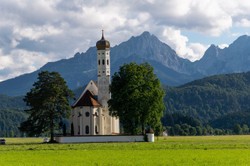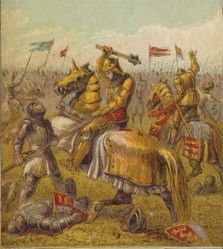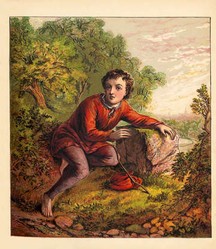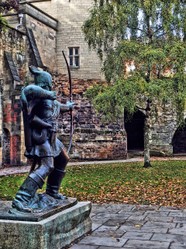Brabbs concentrates on the architectural glories of the mediaeval shrines of Western Europe, mainly those in France and Spain and Portugal. The bulk of this beautiful volume deals with the pilgrim routes on the European mainland. Inevitably, the fact that pilgrimages have come from a great variety of countries, all with the intention of reaching one of several sites, means that there are different routes across the European mainland, some going to the shrine of St James at Compostella in Spain, whereas other routes, such as the Via Francagena, aim to pass over the Alps to enter Italy to reach the centre of Catholic Christianity in Rome. The author has had to make a selection of pilgrim routes, for just as he had to omit Iona in Scotland, so he has been obliged to omit the modern Marian shrine at Fatima in Portugal, which dates from 1917.
Brabbs has some of his enforced selection made for him, for he is concentrating on the aesthetics of the pilgrim experience, so he focuses on the art and architecture that the pilgrims meet en route, and thus the readership is treated to a feast of architectural and aesthetic beauty displayed to us in high quality photography. But the heavy pressures generated by high quality photography mean that he has to be selective of his material, so not all the routes are photographed in detail. Moreover, he finds a way to satisfy the readers' desire for beautiful landscape. There are some landscape shots. One of these is on the Via Francagena, which takes a route from France over the Alps via the St Bernard Pass. This is a lovely landscape.
Most routes tend to pass across France, but there are other countries including Spain, Portugal and parts of western Germany. The German route reaches southwards towards Munich and then joins a route over the Alps. The routes through Spain lead across the Pyrenees and into Spain or sometimes Portugal. The book gives a brief picture of Rome, as if to say that the pilgrim experience is more about travelling to a destination than it is about arriving.
This is a high quality book that will endow any personal library with an aesthetic blessing. I commend it to readers.
I am an Amazon associate and I earn money by qualifying purchases on this page. Paid Link









 TheThousand Year Garden28 days ago
TheThousand Year Garden28 days ago
 Women of the Gospelson 10/11/2025
Women of the Gospelson 10/11/2025
 Religious Gardenson 08/25/2025
Religious Gardenson 08/25/2025
 Doctor of the Church: John Henry Newmanon 08/03/2025
Doctor of the Church: John Henry Newmanon 08/03/2025




Comments
He was unshod on both ascent and descent.
Thank you for your comment below, in answer to my previous observation and question.
Your wife's cousin's husband did the ascent unshod. You mention the descent as more challenging than the ascent.
Was Maureen's cousin's husband -- ( = cousin-in-law?) -- shod or unshod going down Croagh Patrick?
Their accent is fully Irish at all times.
Thank you for your comment below in answer to my previous observation and question.
Would Maureen's cousin Patricia and her husband speak English with a Gaelic accent?
The descent of that rock strewn mountain path is harder than the ascent, as is the case with many peaks. The three of the climbers spoke in English. Patricia and her husband are fluent Gaelic speakers, it is their first language, by choice, but Maureen speaks no Gaelic.
Thank you for your comment below, in answer to my previous observation and question.
Your answer advises us of Maureen, her cousin and her cousin's husband ascending Croagh Patrick. How was the descent?
(Would your wife and her cousin and her cousin's husband have been speaking in English, Gaelic or mixed English and Gaelic?)
She and her cousin, an Irish woman, chose good boots, but the cousin's husband went up unshod. They were ascending Croagh Patrick.
Thank you for your comment below, in answer to my previous observation and question.
Your wife did one of the Irish walks! Did Maureen wear whatever footwear delivered her the most comfort or does a walk demand a certain kind of footwear -- tennis shoes? -- when done non-barefootedly?
Yes, there are pilgrimages to Knock. But walking to Knock is rare, coach and air travel are the preferred ways. The Irish save walking for Croagh Patrick, which is 9ft done barefoot, though Maureen did not go barefoot when she did it. But Lough Derg in Donegal is penitentiary and that is done barefoot.
Thank you for your comment below, in answer to my previous observation and question.
In another direction, albeit related to pilgrimages and relics, is a Marian site such as Knock -- one of my favorites because of its silent manifestation -- also itinerate-able as a pilgrimage site?